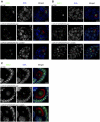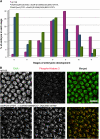polo Is Identified as a Suppressor of bubR1 Nondisjunction in a Deficiency Screen of the Third Chromosome in Drosophila melanogaster
- PMID: 22384328
- PMCID: PMC3276128
- DOI: 10.1534/g3.111.000265
polo Is Identified as a Suppressor of bubR1 Nondisjunction in a Deficiency Screen of the Third Chromosome in Drosophila melanogaster
Abstract
We have previously characterized an EMS-induced allele of the bubR1 gene (bubR1(D1326N)) that separates the two functions of BubR1, causing meiotic nondisjunction but retaining spindle assembly checkpoint activity during somatic cell division in Drosophila melanogaster. Using this allele, we demonstrate that bubR1 meiotic nondisjunction is dosage sensitive, occurs for both exchange and nonexchange homologous chromosomes, and is associated with decreased maintenance of sister chromatid cohesion and of the synaptonemal complex during prophase I progression. We took advantage of these features to perform a genetic screen designed to identify third chromosome deficiencies having a dominant effect on bubR1(D1326N)/bubR1(rev1) meiotic phenotypes. We tested 65 deficiencies covering 60% of the third chromosome euchromatin. Among them, we characterized 24 deficiencies having a dominant effect on bubR1(D1326N)/bubR1(rev1) meiotic phenotypes that we classified in two groups: (1) suppressor of nondisjunction and (2) enhancer of nondisjunction. Among these 24 deficiencies, our results show that deficiencies uncovering the polo locus act as suppressor of bubR1 nondisjunction by delaying meiotic prophase I progression and restoring chiasmata formation as observed by the loading of the condensin subunit SMC2. Furthermore, we identified two deficiencies inducing a lethal phenotype during embryonic development and thus affecting BubR1 kinase activity in somatic cells and one deficiency causing female sterility. Overall, our genetic screening strategy proved to be highly sensitive for the identification of modifiers of BubR1 kinase activity in both meiosis and mitosis.
Figures


Similar articles
-
Drosophila BubR1 is essential for meiotic sister-chromatid cohesion and maintenance of synaptonemal complex.Curr Biol. 2007 Sep 4;17(17):1489-97. doi: 10.1016/j.cub.2007.07.042. Epub 2007 Aug 16. Curr Biol. 2007. PMID: 17702574 Free PMC article.
-
Genetic analysis of sex chromosomal meiotic mutants in Drosophilia melanogaster.Genetics. 1972 Jun;71(2):255-86. doi: 10.1093/genetics/71.2.255. Genetics. 1972. PMID: 4625747 Free PMC article.
-
Isolation and cytogenetic characterization of male meiotic mutants of Drosophila melanogaster.Genetics. 2004 Apr;166(4):1795-806. doi: 10.1534/genetics.166.4.1795. Genetics. 2004. PMID: 15126399 Free PMC article.
-
[Genetic control of meiosis in Drozophila].Genetika. 2000 Oct;36(10):1301-21. Genetika. 2000. PMID: 11094742 Review. Russian.
-
A model for chromosome structure during the mitotic and meiotic cell cycles.Chromosome Res. 2001;9(3):175-98. doi: 10.1023/a:1016690802570. Chromosome Res. 2001. PMID: 11330393 Review.
Cited by
-
unfulfilled interacting genes display branch-specific roles in the development of mushroom body axons in Drosophila melanogaster.G3 (Bethesda). 2014 Apr 16;4(4):693-706. doi: 10.1534/g3.113.009829. G3 (Bethesda). 2014. PMID: 24558265 Free PMC article.
-
Female Meiosis: Synapsis, Recombination, and Segregation in Drosophila melanogaster.Genetics. 2018 Mar;208(3):875-908. doi: 10.1534/genetics.117.300081. Genetics. 2018. PMID: 29487146 Free PMC article. Review.
References
-
- Alberts B., Johnson A., Lewis J., Raff M., Roberts K., 2002. Molecular Biology of the Cell. Garland, New York
-
- Berdnik D., Knoblich J. A., 2002. Drosophila Aurora-A is required for centrosome maturation and actin-dependent asymmetric protein localization during mitosis. Curr. Biol. 12: 640–647 - PubMed
LinkOut - more resources
Full Text Sources
Molecular Biology Databases
